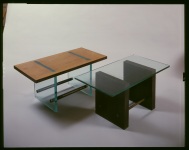THE THIRTIES: THE GREAT THEMES
At the 4th Triennial Exhibition in Monza, in 1930, it was the Palladian Gio Ponti who promoted the Electric House designed by the young rationalists Figini and Pollini, while he himself was represented by the neoclassical Vacation House. That was how Gio Ponti worked. During this great and controversial decade for Italian architecture, the young Ponti went straight into the eye of the storm, with Domus and the Triennale (the 5th Triennial Exhibition, in 1933, was his). His design was innovative but he stayed on the sidelines of the theoretical and political debate perhaps this is where his innate neoclassicism lies. His admiration was for the individual artists (from Terragni to de Chirico) and his interest lay, at the same time, in custom. This is how it would always be. He himself appeared to be, in these years, a multiplicity of individual artists, proceeding, he would say, by ramblings and by chance occurrences as well. He worked in Milan, Rome, Padua and Vienna. Milan provided him with great private opportunities: from domestic architecture (the Typical houses» or «Domus, 1931—36) to designing for industry, first Montecatini Building, 1936, building and fittings, to a case of industrial design on an architectural scale like the steel tower in the park Torre Littoria, 1933. Rome provided him with great public occasions: the first major competitions lost Palazzo del Littorio or Fascist Headquarters, 1936, Foreign Ministry, 1939, commissions that came to nothing (a preliminary master plan for Addis Ababa, with Vaccaro and Del Debbio, 1936, a House of Italy in Buenos Aires, 1937) and two successes (the School of Mathematics at the new university campus, 1934, and the Exhibition of the Catholic Press in the Vatican, 1936). Padua gave him the opportunity to build the memorable atrium of the Liviano (the seat of the Faculty of Letters at the University of Padua) in 1937, a space he devised for Campigli's vast fresco and Martini's huge sculpture, in accordance with the idea of grand decoration. Check: Publix Weekly Ad and CVS Weekly Ad. Vienna brought him back to domesticity with the furnishings for the Furstenberg Palace and seemed to teach him, through its architects, the value of architecture without an architect. With the Austrian architect Bernard Rudofsky, Ponti developed his Mediterranean design in these years. From 1933 to 1945 Gio Ponti was in partnership with the engineers Antonio Fornaroli and Eugenio Soncini.
From "Gio Ponti, l'opera" by Lisa Licitra Ponti,1990, Leonardo Editore
-
Design of the "Lighter-than-air Room"at the Italian Aeronautical Exhibition1934Palazzo dell'Arte, Milan




















































